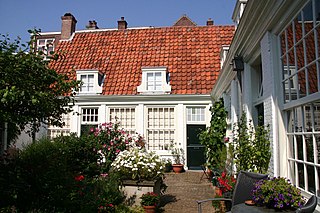
The Lutherse Hofje is a hofje in Haarlem, Netherlands.

The Lutherse Hofje is a hofje in Haarlem, Netherlands.
The hofje was founded by the Lutheran Church in 1615. Originally the people living in the hofje were members of this church, but nowadays only the board of the hofje is appointed by the Lutheran Church. The hofje adjoins the Lutheran church itself, and has an unusual addition in the garden, namely an outdoor pulpit. From this pulpit, the minister could address the women in the hofje.
With five houses, it is the smallest hofje in Haarlem.
Location: Witte Herenstraat 20
Coordinates: 52°23′02″N4°37′54″E / 52.38389°N 4.63167°E

The Hofje van Bakenes or Bakenesserkamer is a hofje in Haarlem, Netherlands, located between the Bakenessergracht and the Wijde Appelaarsteeg. In the Middle Ages "kamer" or "room" meant house. Usually the houses within a hofje consisted of just one room.

The Hofje van Noblet is a hofje in Haarlem, Netherlands.

The Frans Loenenhofje is a hofje in Haarlem, Netherlands, on the Witte Heren straat.

The Hofje van Staats is a hofje in Haarlem, Netherlands, on the Jansweg 39, close to the Haarlem railway station.

The Hofje van Loo is a hofje on the Barrevoetstraat 7 in Haarlem, Netherlands.

The Teylershofje is a hofje in Haarlem, Netherlands with 24 houses.

Haarlem is one of the cities in the Netherlands that has a number of hofjes. Some of them are still in use with boards of regents. Many of these are members of the Stichting Haarlemse Hofjes. The word 'hofje' just means small garden, because the hofjes are generally small houses grouped around a community kitchen garden with a water pump. Often they were attached to a larger field for bleaching linen or growing orchards, but today those fields have been long used for city expansion and only the central gardens can still be seen.

Hofje van Guurtje de Waal is a hofje in Haarlem, Netherlands.

The Remonstrantshofje is a hofje in Haarlem, Netherlands. It is one of the hofjes in Haarlem that is traditionally used to provide housing for elderly people.

The Bruiningshofje is a hofje in Haarlem, Netherlands.

The Brouwershofje is a hofje on the Tuchthuisstraat in Haarlem, Netherlands.

The Hofje van Willem Heythuijsen is a hofje in Haarlem, Netherlands. It was founded in 1650 by the testament of Willem van Heythuysen on the site of his summer residence outside the city walls of Haarlem on land that was considered Heemstede property until it was annexed in 1927. It is one of the few hofjes of Haarlem to be built outside the city walls. It has a 'T' shape and has a small open courtyard and a garden still intact.

The Wijnbergshofje is a hofje in Haarlem, Netherlands, on the Barrevoetstraat.

The Zuiderhofje is a hofje in Haarlem, Netherlands.

The Vrouwe- en Antonie Gasthuis is a hofje on the Klein Heiligland 64a in Haarlem, Netherlands. It is open on weekdays from 10-17.00.

The Proveniershuis is a hofje and former schutterij on the Grote Houtstraat in Haarlem, Netherlands.

The Hofje van Codde en Beresteyn is a hofje in Haarlem, Netherlands. The current building is from 1968 and is located on the J. Cuyperstraat, which is named for the architect who designed the Cathedral of Saint Bavo next door, Joseph Cuypers. This hofje is the wealthiest hofje foundation in Haarlem with the most modern facilities for its inhabitants. Poor (devote) Catholic women of Haarlem 60 years and older are still welcome to live there for free.

The Lutherse kerk in Haarlem is a Lutheran church dating from the 17th century on the Witte Herenstraat in Haarlem, Netherlands.

The Johan Enschedé Hof is a hofje in Haarlem, Netherlands, on the Korte Begijnestraat. Via a rear entrance it is linked to the Hofje van Bakenes.

The Coomanshof is a former hofje in Haarlem, Netherlands, on the Witte Heren straat.